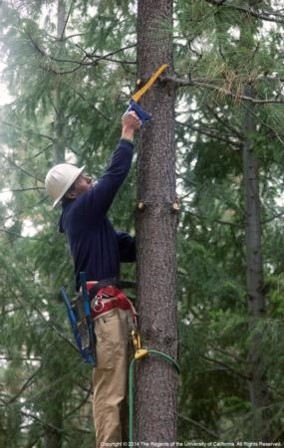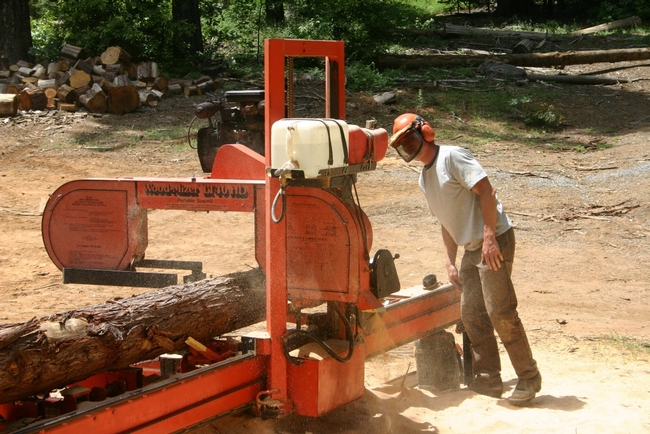Navigating natural resource management rules and regulations in California can be daunting for private forest landowners. California's Forest Practice Rules were created in 1974, and have evolved over the years through a collaborative process between Registered Professional Foresters, landowners and regulators. Proponents would say these rules have protected public resource values and emphasize the importance in planning for sustainable resources management. Opponents would say these rules have been taken to an extreme, taking away landowner's flexibility in managing their forestland and increasing costs that prevent work from occurring. UC Cooperative Extension Specialist and Registered Professional Forester Rob York, would say there is no need to be on one side of the debate or the other. Private forest landowners can accomplish much towards their management goals, both within and outside of the permitting process. The key is understanding what you can and cannot do within the Forest Practice Rules, and then getting started!
Rob York hand pruning
According to Rob York, private forest landowners need to start with an understanding of the following legal definitions, as they determine whether or not you need a permit to proceed:
- Timberland is land that is available for, and capable of, growing a crop of trees of a commercial species to produce lumber and other forest products. Cutting trees (see commercial species below) for commercial purposes on timberland, requires a permit.
- Commercial species (otherwise known as Group A) includes sugar pine, white fir, ponderosa pine, Douglas-fir, incense cedar, coast redwood, red fir, noble fir, western white pine and Port Orford cedar. Other species, known as Group B, must grow with Group A species in order to be considered commercial. This includes knobcone pine, giant sequoia, gray pine, chinkapin, California black oak, foxtail pine, Oregon white oak, alder, tanoak, Monterey Pine, hemlock, Pacific madrone and juniper.
- Timber operations is the cutting and/or removal of timber or other solid wood forest products, including Christmas trees, from timberlands for commercial purposes, including the conversion of timberland to other purposes such as residential uses. Timber operations require a permit.
Q: What is the definition of commercial purposes and why is this important?
A: Commercial purpose means the sale, barter, exchange or trade of any wood product originating from timberland. It does not matter if the landowner has procured the wood product themselves, or had a licensed timber operator harvest trees. If the end product will be sold, bartered, exchanged or traded for other products or services, it is a commercial product. This is important because it determines if you need a permit or not to harvest the wood product.
Q: What are some activities that a forest landowner can do without a permit?
A: A landowner can cut down trees for their own personal use such as for fencing, firewood, or construction. You can thin trees and leave them on you property or give the wood away for free all without a permit (though some counties may have additional rules about this). Additionally, a landowner can construct trails (though there may be regulations if the trail intersects a water course), collect cones, and pile burn, all without a permit from Cal Fire (depending on season). Remember though, if you are going to burn, you may need a permit from your local air quality district.
Rob York with a portable saw mill
Q: What activities require a permit?
A: Timber/biomass harvesting conducted through a Timber Harvest Plan (THP), or thinning and fuels reduction projects conducted through exemptions from California Environmental Quality Act (CEQA) require a permit through Cal Fire. If you plan on selling, bartering, exchanging or trading any wood product, you need a permit. If you harvested wood products with intent to not sell, barter, exchange or trade, and then you change your mind, you need a permit.
Q: What can I do under a Timber Harvest Plan?
A: A THP allows for a single commercial harvest of timber, including even-aged management and large tree removal. A THP must be developed by a Registered Professional Forester (RPF) and conducted by a Licensed Timber Operator (LTO). It is good for a period of 5 years and has the potential for a 2 year extension.
Q: Are there other permitting options?
A: Yes! A Nonindustrial Timber Management Plan (NTMP) and a Working Forest Management Plan (WFMP) are good options for private forest landowners with smaller acreage. Both require an RPF to develop the plan and limit silviculture activity to uneven-aged regeneration methods, but once they are approved by Cal Fire, they never expire and can transfer to a new landowner. When you are ready to harvest, you simply notify Cal Fire.
Another option is to conduct forest management activities under a Dead Tree Removal and Fuel Reduction Permit Exemption. Exemptions are categorized by intent to address things such as responding to or preventing disasters, and restoration efforts. They may or may not require an RPF to develop and will have certain limitations associated with them such as acreage, diameter limits and silviculture or stocking requirements. Exemptions are only valid for 1 year.
For more information on forest management policy, regulations and planning, please see Forest Stewardship Series 19 Laws and Regulations Affecting Forests, Part I: Timber Harvesting, UC ANR Publication 8249, Forest Stewardship Series 20 Laws and Regulations Affecting Forests, Part II: Activities Other Than Timber Harvesting, UC ANR Publication 8250, and Frequently asked questions about managing forest lands in California.

